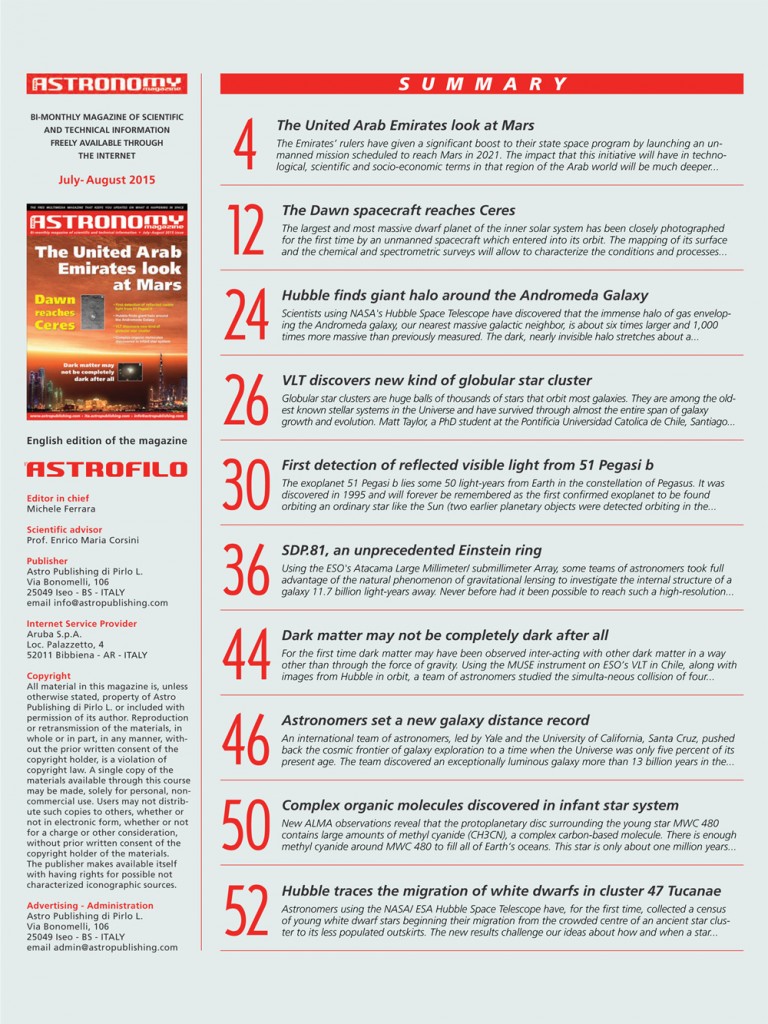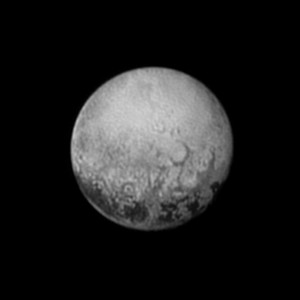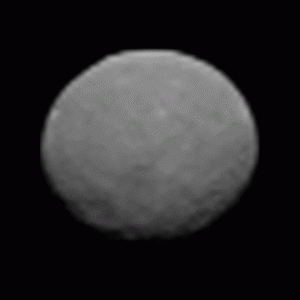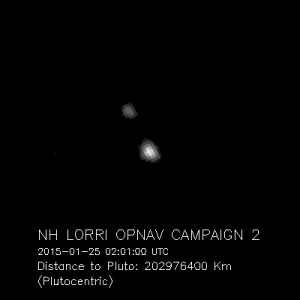Greetings fellow astrophiles,
The NASA News service provides up-to-date announcements of NASA policy, news events, and space science. A recent selection of space science articles are provided below, including direct links to the full announcements. Those interested in receiving these news announcements directly from NASA can subscribe to their service by sending an email to:
hqnews-request@newsletters.nasa.gov?subject=subscribe
NASA’s Chandra Observatory Finds Cosmic Showers Halt Galaxy Growth
RELEASE 15-028 (Click here for the full article) – 4 March 2015
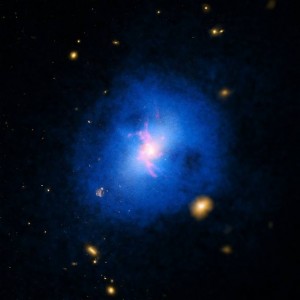 Using NASA’s Chandra X-ray Observatory, astronomers have found that the growth of galaxies containing supermassive black holes can be slowed down by a phenomenon referred to as cosmic precipitation.
Using NASA’s Chandra X-ray Observatory, astronomers have found that the growth of galaxies containing supermassive black holes can be slowed down by a phenomenon referred to as cosmic precipitation.
Cosmic precipitation is not a weather event, as we commonly associate the word — rain, sleet, or snow. Rather, it is a mechanism that allows hot gas to produce showers of cool gas clouds that fall into a galaxy. Researchers have analyzed X-rays from more than 200 galaxy clusters, and believe that this gaseous precipitation is key to understanding how giant black holes affect the growth of galaxies.
“We know that precipitation can slow us down on our way to work,” said Mark Voit of Michigan State University (MSU) in East Lansing, lead author of the paper that appears in the latest issue of Nature. “Now we have evidence that it can also slow down star formation in galaxies with huge black holes.”
…
An interactive image, podcast, and video about these findings are available at: chandra.si.edu
For more Chandra images, multimedia and related materials, visit: www.nasa.gov/chandra
NASA Research Suggests Mars Once Had More Water Than Earth’s Arctic Ocean
RELEASE 15-032 (Click here for the full article) – 5 March 2015
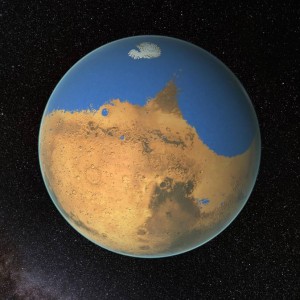 A primitive ocean on Mars held more water than Earth’s Arctic Ocean, according to NASA scientists who, using ground-based observatories, measured water signatures in the Red Planet’s atmosphere.
A primitive ocean on Mars held more water than Earth’s Arctic Ocean, according to NASA scientists who, using ground-based observatories, measured water signatures in the Red Planet’s atmosphere.
Scientists have been searching for answers to why this vast water supply left the surface. Details of the observations and computations appear in Thursday’s edition of Science magazine.
“Our study provides a solid estimate of how much water Mars once had, by determining how much water was lost to space,” said Geronimo Villanueva, a scientist at NASA’s Goddard Space Flight Center in Greenbelt, Maryland, and lead author of the new paper. “With this work, we can better understand the history of water on Mars.”
Perhaps about 4.3 billion years ago, Mars would have had enough water to cover its entire surface in a liquid layer about 450 feet (137 meters) deep. More likely, the water would have formed an ocean occupying almost half of Mars’ northern hemisphere, in some regions reaching depths greater than a mile (1.6 kilometers).
…
To view a video of this finding, visit: youtu.be/WH8kHncLZwM
More information about NASA’s Mars programs is online at: www.nasa.gov/mars
NASA Spacecraft Becomes First To Orbit A Dwarf Planet
RELEASE 15-034 (Click here for the full article) – 6 March 2015
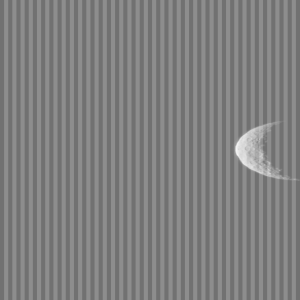 NASA’s Dawn spacecraft has become the first mission to achieve orbit around a dwarf planet. The spacecraft was approximately 38,000 miles (61,000 kilometers) from Ceres when it was captured by the dwarf planet’s gravity at about 4:39 a.m. PST (7:39 a.m. EST) Friday.
NASA’s Dawn spacecraft has become the first mission to achieve orbit around a dwarf planet. The spacecraft was approximately 38,000 miles (61,000 kilometers) from Ceres when it was captured by the dwarf planet’s gravity at about 4:39 a.m. PST (7:39 a.m. EST) Friday.
Mission controllers at NASA’s Jet Propulsion Laboratory (JPL) in Pasadena, California received a signal from the spacecraft at 5:36 a.m. PST (8:36 a.m. EST) that Dawn was healthy and thrusting with its ion engine, the indicator Dawn had entered orbit as planned.
“Since its discovery in 1801, Ceres was known as a planet, then an asteroid and later a dwarf planet,” said Marc Rayman, Dawn chief engineer and mission director at JPL. “Now, after a journey of 3.1 billion miles (4.9 billion kilometers) and 7.5 years, Dawn calls Ceres, home.”
In addition to being the first spacecraft to visit a dwarf planet, Dawn also has the distinction of being the first mission to orbit two extraterrestrial targets. From 2011 to 2012, the spacecraft explored the giant asteroid Vesta, delivering new insights and thousands of images from that distant world. Ceres and Vesta are the two most massive residents of our solar system’s main asteroid belt between Mars and Jupiter.
…
For a complete list of mission participants, visit: dawn.jpl.nasa.gov/mission
For more information about Dawn, visit: www.nasa.gov/dawn
Spacecraft Data Suggest Saturn Moon’s Ocean May Harbor Hydrothermal Activity
RELEASE 15-036 (Click here for the full article) – 11 March 2015
 NASA’s Cassini spacecraft has provided scientists the first clear evidence that Saturn’s moon Enceladus exhibits signs of present-day hydrothermal activity which may resemble that seen in the deep oceans on Earth. The implications of such activity on a world other than our planet open up unprecedented scientific possibilities.
NASA’s Cassini spacecraft has provided scientists the first clear evidence that Saturn’s moon Enceladus exhibits signs of present-day hydrothermal activity which may resemble that seen in the deep oceans on Earth. The implications of such activity on a world other than our planet open up unprecedented scientific possibilities.
“These findings add to the possibility that Enceladus, which contains a subsurface ocean and displays remarkable geologic activity, could contain environments suitable for living organisms,” said John Grunsfeld astronaut and associate administrator of NASA’s Science Mission Directorate in Washington. “The locations in our solar system where extreme environments occur in which life might exist may bring us closer to answering the question: are we alone in the Universe.”
Hydrothermal activity occurs when seawater infiltrates and reacts with a rocky crust and emerges as a heated, mineral-laden solution, a natural occurrence in Earth’s oceans. According to two science papers, the results are the first clear indications an icy moon may have similar ongoing active processes.
…
More information about Cassini, visit: www.nasa.gov/cassini and saturn.jpl.nasa.gov
NASA’s Hubble Observations Suggest Underground Ocean On Jupiter’s Largest Moon
RELEASE 15-033 (Click here for the full article) – 12 March 2015
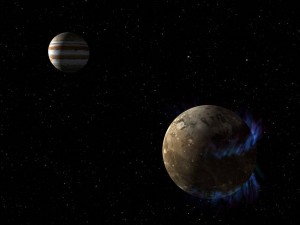 NASA’s Hubble Space Telescope has the best evidence yet for an underground saltwater ocean on Ganymede, Jupiter’s largest moon. The subterranean ocean is thought to have more water than all the water on Earth’s surface.
NASA’s Hubble Space Telescope has the best evidence yet for an underground saltwater ocean on Ganymede, Jupiter’s largest moon. The subterranean ocean is thought to have more water than all the water on Earth’s surface.
Identifying liquid water is crucial in the search for habitable worlds beyond Earth and for the search of life as we know it.
“This discovery marks a significant milestone, highlighting what only Hubble can accomplish,” said John Grunsfeld, associate administrator of NASA’s Science Mission Directorate at NASA Headquarters, Washington. “In its 25 years in orbit, Hubble has made many scientific discoveries in our own solar system. A deep ocean under the icy crust of Ganymede opens up further exciting possibilities for life beyond Earth.”
Ganymede is the largest moon in our solar system and the only moon with its own magnetic field. The magnetic field causes aurorae, which are ribbons of glowing, hot electrified gas, in regions circling the north and south poles of the moon. Because Ganymede is close to Jupiter, it is also embedded in Jupiter’s magnetic field. When Jupiter’s magnetic field changes, the aurorae on Ganymede also change, “rocking” back and forth.
…
For images and more information about Hubble, visit: www.nasa.gov/hubble and hubblesite.org/news/2015/09
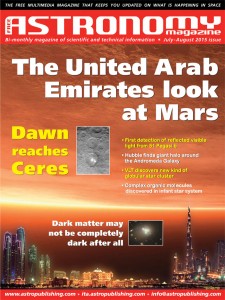 The most recent issue of Free Astronomy Magazine (July-August, 2015) is available for your reading and downloading pleasure at www.astropublishing.com (click the link to go directly to the issue).
The most recent issue of Free Astronomy Magazine (July-August, 2015) is available for your reading and downloading pleasure at www.astropublishing.com (click the link to go directly to the issue).
